Arizona Travels & Tours
Pictures, Photos, Images, & Reviews.
Park Of The Canals
Ancient Hohokam Ruins
Mesa, Arizona, USA
George and Eve DeLange
Google Map To Park Of The Canals, Mesa, Arizona
View Larger Map
We Are Proud Of Our SafeSurf Rating!

Click On Any Of The Following Links By Amazon.Com
For Books, & Videos About Touring Arizona. No Obligation!
Click On Any Of The Following Links By Amazon.Com
For Books, & Videos About About Arizona Native American Ruins. No Obligation!


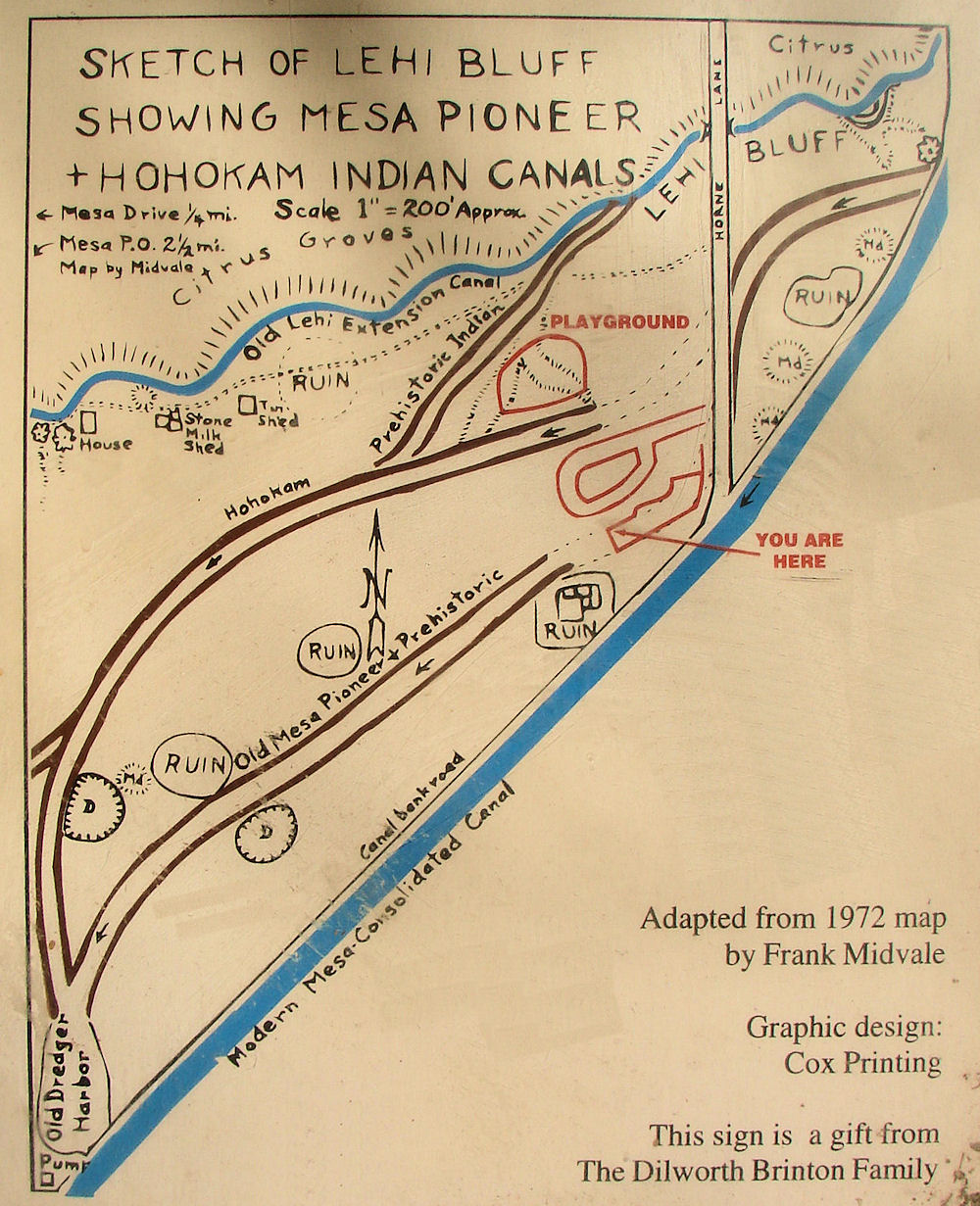 |
| Frank Midvale Archaeological Map. Park Of The Canals, Mesa, Arizona. Ancient Hohokam Ruins. Photo January 12, 2010. |
|---|
 |
| Park Of The Canals, Mesa, Arizona. Ancient Hohokam Ruins. Looking NE. "Hohokam/Mormon Canal." Channel Dug By "Mesa Party" In 1877. View From Top Of Hohokam Ruins. Photo January 12, 2010. |
|---|
 |
| Park Of The Canals, Mesa, Arizona. Ancient Hohokam Ruins. Looking NE. "Hohokam/Mormon Canal." Channel Dug By "Mesa Party" In 1877. View From Top Of Canal Ruins. Photo January 12, 2010. |
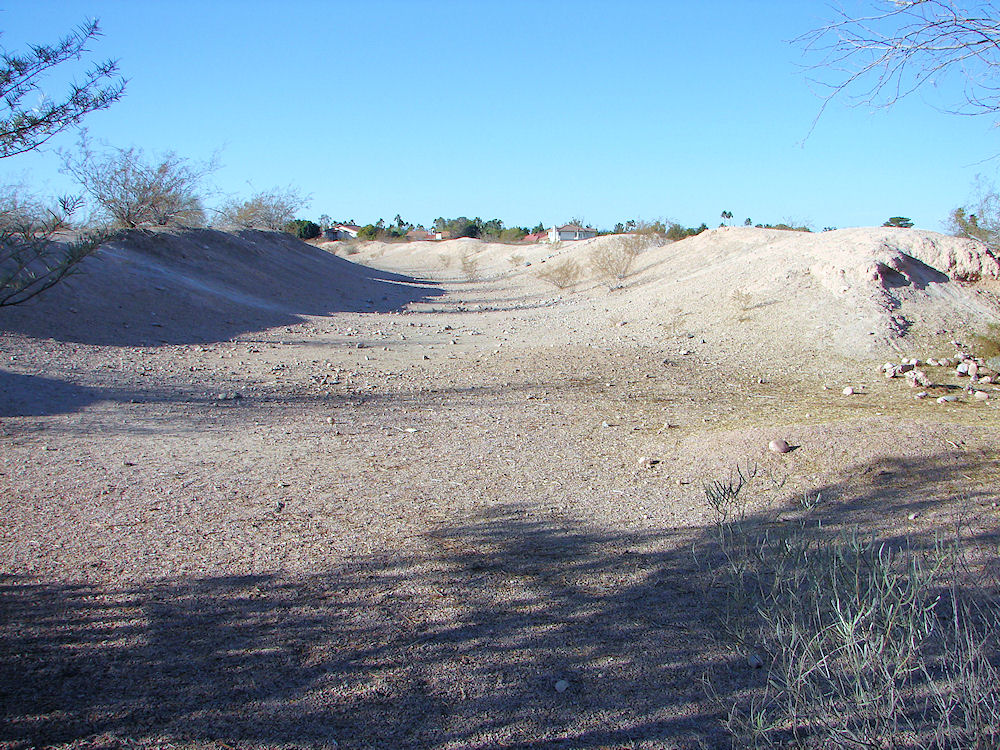 |
| Park Of The Canals, Mesa, Arizona. Ancient Hohokam Ruins. Looking SW. First Channel Dug For Dr. A.J. Chandler & His Consolidated Canal Company In About 1891. Canal. Photo January 12, 2010. View From Bottom Of Canal Ruins. Photo January 12, 2010. |
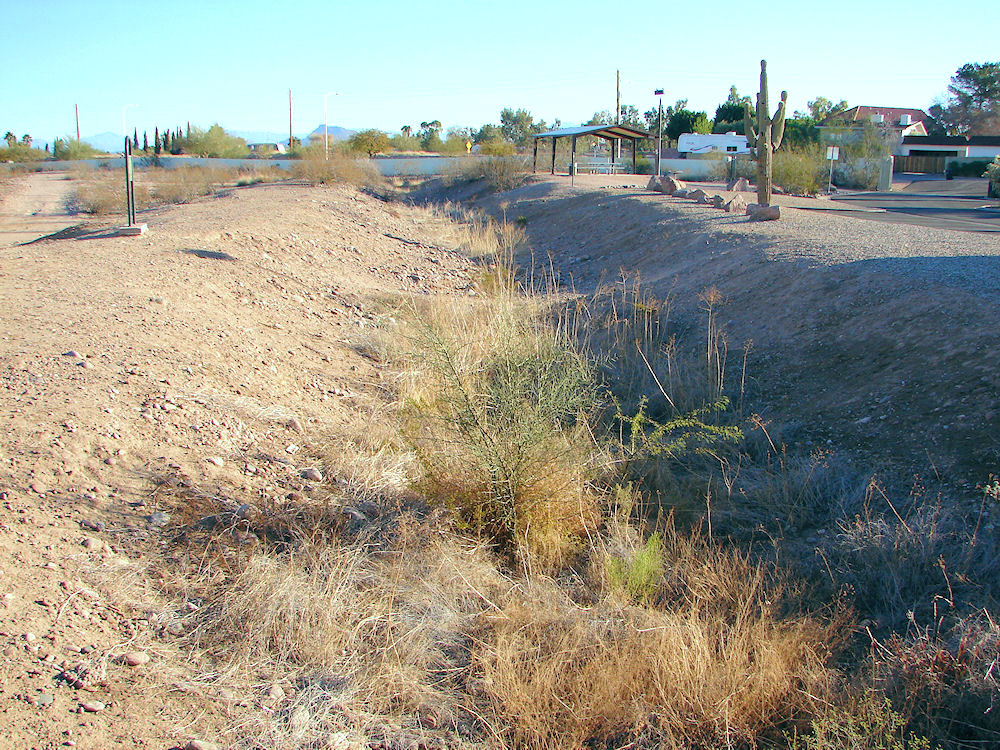 |
| Park Of The Canals, Mesa, Arizona. Ancient Hohokam Ruins. Looking NE. "Hohokam/Mormon Canal." Channel Dug By "Mesa Party" In 1877. View From Top Of Canal Ruins. Photo January 12, 2010. |
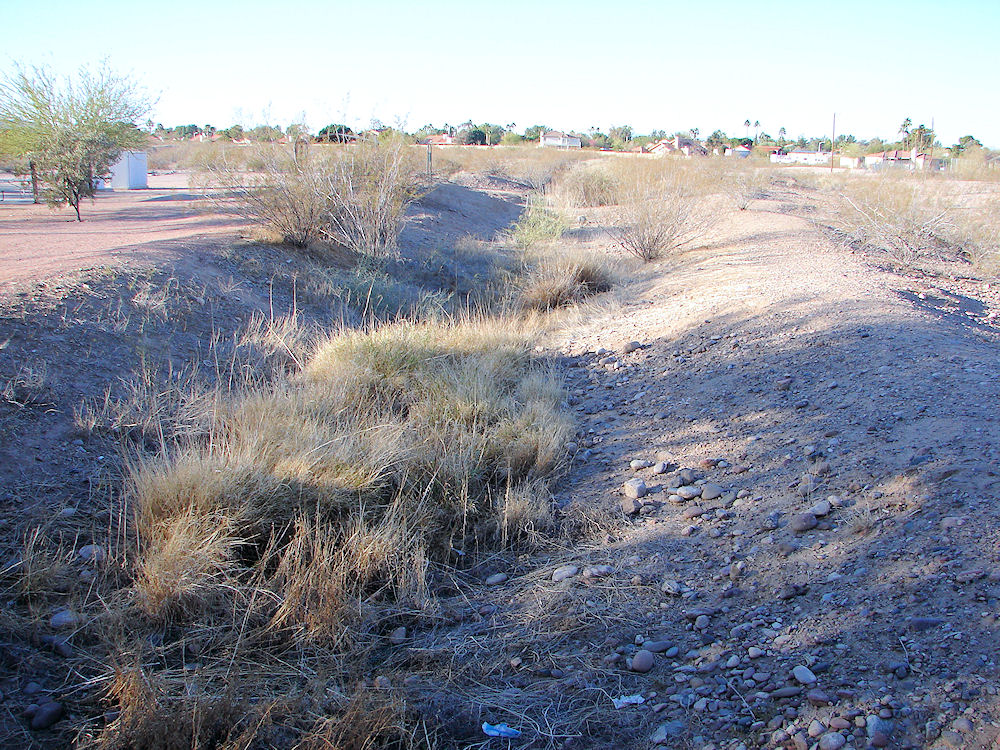 |
| Park Of The Canals, Mesa, Arizona. Ancient Hohokam Ruins. Looking SW. First Channel Dug For Dr. A.J. Chandler & His Consolidated Canal Company In About 1891. Canal. Photo January 12, 2010. |
 |
| Park Of The Canals, Mesa, Arizona. Ancient Hohokam Ruins. Looking SW. Photo January 12, 2010. |
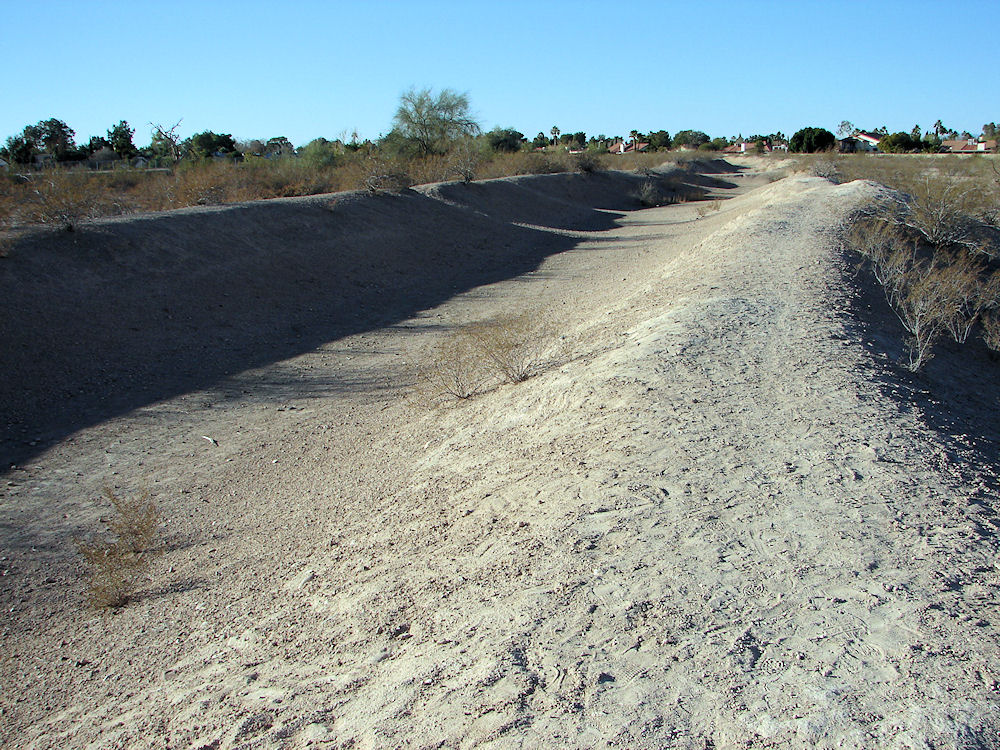 |
| Park Of The Canals, Mesa, Arizona. Ancient Hohokam Ruins. Looking SW. First Channel Dug For Dr. A.J. Chandler & His Consolidated Canal Company In About 1891. Canal. Photo January 12, 2010. |
This is the easiest way to actually visit an ancient Hohokam canal in all of Arizona. Many of the locals don't even know that this ancient Hohokam canal exists and is in the City of Mesa, Arizona. It is thought that the Hohokam were the first people to settle Mesa. The "Park Of The Canals" Canal Ruins, which dates from the Hohokam Classic Period, was listed on the National Register of Historic Places on May 30, 1975. A Google Earth Map search marks the center of the Mesa Grande Hohokam Ruins at 33o 26' 46.04" N 111o 48' 49.99" W. The elevation is about 1,257 feet. In 1865 at a ferry west of present-day Val Vista Road, a settlement called Maryville was formed. The ferry was used by US soldiers. Then in 1877, after Maryville had been abandoned, a group of LDS pioneers, led by Daniel Webster Jones, who had been asked by LDS officials to direct a party of people in establishing a settlement in Arizona, arrived and settled in an area called Lehi. Then in 1878 an 85 member LDS pioneer contingent called "The First Mesa Company" arrived from Utah and Idaho. They decided not to stay with Daniel Webster Jones' group in Lehi and moved southward and began to clear out the ancient Hohokam canals; so that they might move water once more. They marked off land and immediately began work clearing the original Hohokam canals; the river water entered the canals in April. Evidence of the canals can be seen today at the 31-acre "Park of the Canals." This is one of the only areas where the remains (about 4,500 feet) of the prehistoric canals, built in about 700 BC, can be easily observed. In addition to the canal remains, the park, boasts a desert botanical garden, which features approximately 150 species of cacti and other desert plants featuring vegetation from four different desert regions. Additionally, a large playground area is available for children. It is thought that the original canals were used by the ancient Hohokam (ho-ho-KAHM) people in Mesa, Arizona. According to oral tradition, the Hohokam may be the ancestors of the historic Akimel O'odham and Tohono O'odham peoples in Southern Arizona. The Hohokam culture, which spanned some 1450 years � from 1 A. D. in the first millennium to A. D. 1450 � suddenly appeared and vanished into the darkness of history. During that time, the Hohokam raised new standards in innovation, art, and craftsmanship. They also had trade and cultural connections into Mesoamerica. Based upon the first archaeological evidence, researchers believed that early Hohokam pioneers into northern Sonora and southern Arizona, imported a more advanced Mesoamerican influence into the area, founding the Hohokam culture, around the beginning of the first millennium. Based upon later archaeological evidence, other researchers believed that local descendants of the ancient hunting and gathering traditions of the desert, responded to influences from Mesoamerica and emerged as the Hohokam. Yet other students have suggested that the Hohokam immigrants arrived from an unknown Mesoamerican region and swept across the deserts of southern Arizona and northern Mexico. It is thought by those researchers that the Hohokam immigrants probably over ran the hunter/gatherers in the region of southern Arizona, sometime in the second half of the first millennium. Yet other investigators say that the Hohokam region was nothing more than a Mesoamerican frontier outpost. And others believe that the Hohokam culture represented nothing more than a local cultural development with a Mesoamerican tint. In any case, not much is known about their origins. The Hohokam occupied a geologically and ecologically diverse region, which extended from the basin and range and the low desert country of northern Sonora and southern Arizona northward into the Mogollon Rim escarpment and onto the southwestern edge of the Colorado Plateau. The Hohokam people had many settlements in the Gila and Salt River valleys of southern Arizona. They built rectangular pit houses from earth, rather than stone, and lived in small villages. They cremated their dead and placed the ashes in a specially prepared pit Although the Hohokam relied a great deal on hunting and gathering, they also were skilled farmers and excellent engineers. They were a peaceful people who cooperated to build large canal networks. Some of their canals were over ten miles long and used gravity to control water flow and to flush out the silt. Between the 7th and 14th centuries they built and maintained these extensive irrigation networks along the lower Salt and middle Gila rivers that rivaled the complexity of those used in the ancient Near East, Egypt, and China. These were constructed using relatively simple excavation tools, without the benefit of advanced engineering technologies. These highly successful agricultural techniques produced a surplus of food. Villages and populations grew. Over the next 1500 years the Hohokam expanded their settlements into the Tucson Basin, then to the Phoenix area, and as far north as present-day Flagstaff.
Important Update Note:
We have been contacted by Jerry B. Howard, Ph.D., the Curator of Anthropology at the Arizona Museum of Natural History concerning his new research at the "Park Of The Canals," Canal Ruins. Doctor Howard's evidence, shows that our understanding of the names for the two main canals in the Park, is in the process of being revised and updated. As is the proper thing to do, as new knowledge through proper archaeological studies comes to light! We will present some of his new evidence here for you to ponder. This concerns the placement of the signs that were first placed in the Park. Dillworth Carlos Brinton insisted that his signs were correct �according to my grandfather.� The new evidence proves that the statement by grandfather, David Branson Brinton, is incorrect. "The large canal to the south is not the Mormon\Hohokam canal, it is the first channel dug for Chandler�s 1891 canal. The �Hohokam� canal to the north is actually the Hohokam\Mormon canal � the canal the Mesa Party dug back out around 1877." "I have conducted archaeological excavation on both canals and the evidence is very clear. The southern canal has a modern trapezoidal shape and shallow design � along with historic dates we obtained (archaeomagnetic dating) and we even found the tooth marks in the base of the canal from Chandler�s steam powered dredge! In the north canal I found two distinct channels with distinct flow and depositional characteristics, the earlier associated with Hohokam ceramics and the later associated with historic artifacts." Again, we wish to thank Dr. Jerry B. Howard, Ph.D., for clearing up this issue. We have made the appropriate changes on this page to the photographs that we have labeled.
The Physical Location Is: Park Of The Canals: 1710 N. Horne Mesa, AZ.
|
If you are planning to visit the "Park Of The Canals". And if you are coming from outside of Arizona, you could fly into the Phoenix Sky Harbor International Airport and then rent a car. There are many hotels and motels in the area. We have some links to Priceline.com on this page since they can arrange all of your air flights, hotels and car. We also have some links to Altrec.com on this page since they are a good online source for any outdoor camping gear and clothing that you may need. We of course, appreciate your use of the advertising on our pages, since it helps us to keep our pages active.
|
 | 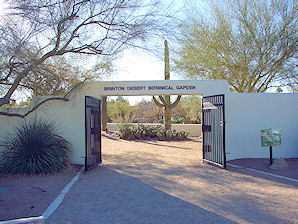 |
| Entrance To The Park Of The Canals, Mesa, Arizona. | Entrance To The Brinton Desert Botanical Garden Park Of The Canals, Mesa, Arizona. |
|---|
We Are Proud Of Our SafeSurf Rating!

Click On Any Of The Following Links By Amazon.Com
For Books, & Videos About Touring Arizona. No Obligation!
Click On Any Of The Following Links By Amazon.Com
For Books, & Videos About About Arizona Native American Ruins. No Obligation!


